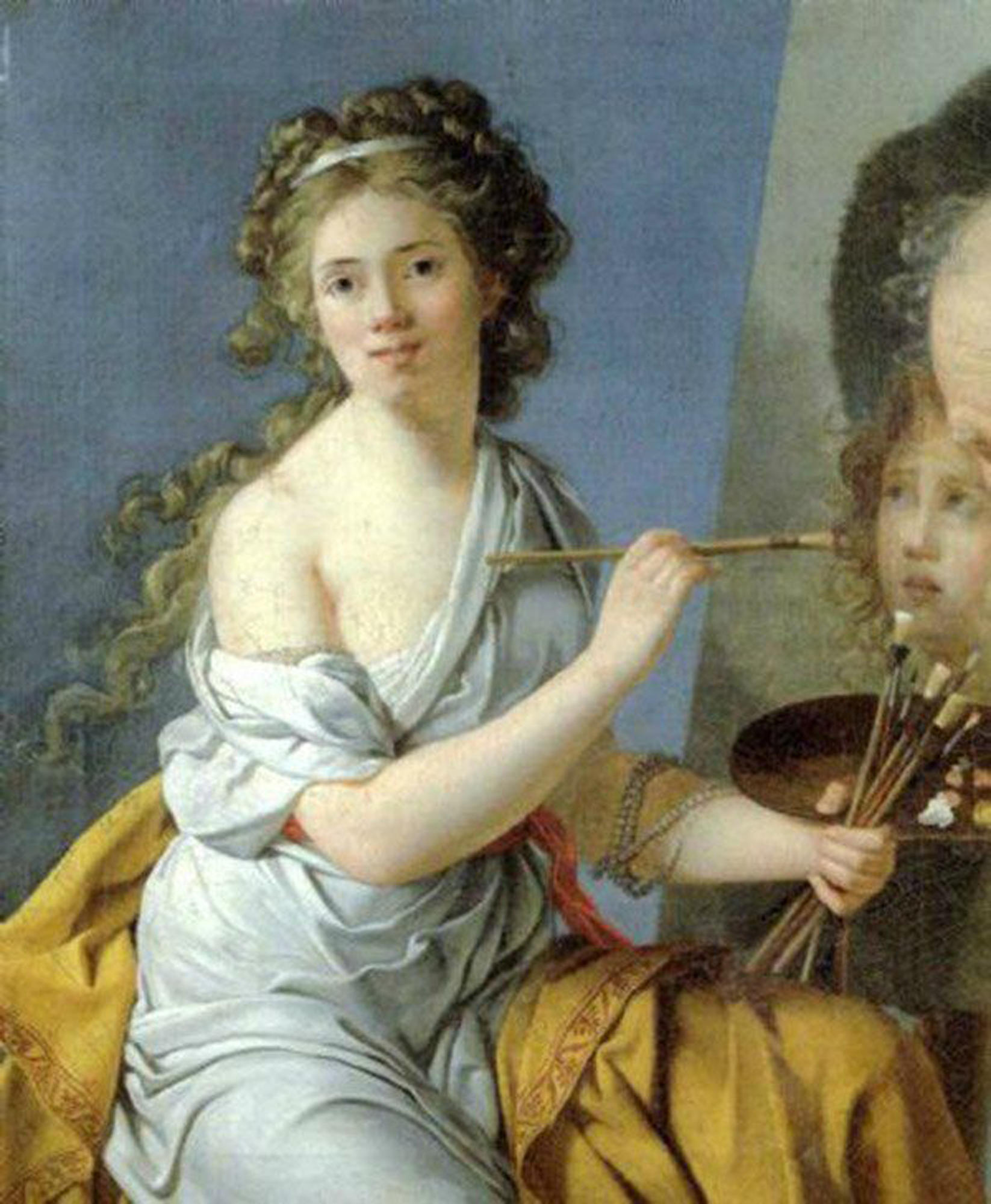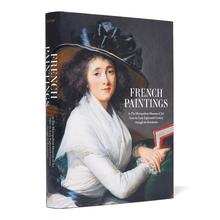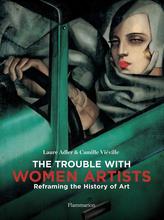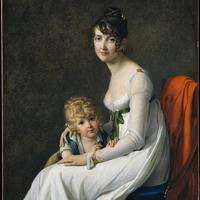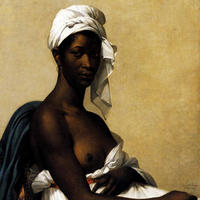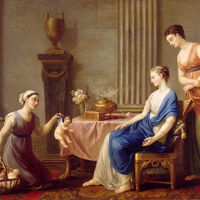More about Marie-Guillemine Benoist
- All
- Info
- Shop
Works by Marie-Guillemine Benoist

Sr. Contributor
Marie-Guillemine Benoist was a badass feminist who got a raw deal.
She studied under fellow pioneering female artist Louise Vigee Le Brun, and Jacques-Louis David. She was one of the only pupils Vigee Le Brun mentioned by name in her memoirs. Like her mentor Le Brun, Benoist was beautiful, socially well-connected, and married to a prominent man; early advantages to her success which would eventually screw her over.
Benoist’s husband was a translator, and she illustrated many of his books, including abolitionist texts and a feminist work by Mary Wollstonecraft. Benoist incorporated feminist themes into her art, such as The Innocence between Virtue and Vice. The corruptive Vice was traditionally portrayed as a seductive woman. Benoist reversed the roles by portraying Vice as a handsome young man pursuing Innocence, a maiden fleeing into the protective arms of a wise, female Virtue.
At the height of her success, Benoist painted Napoleon and several members of his family, but her most famous painting depicts an unknown black woman. Portrait d’une femme noire shows a beautiful, dignified black woman with an exposed breast, the subject of her own portrait. At the time, it was fashionable to depict people of color as objects in relation to white sitters, so this was radical! The mild nudity also caused something of a sensation. Abolitionism was a hot topic at the time, and Benoist’s painting became a symbol of the movement.
Controversial (and notably male) art critic Julian Spalding suggests that her paintings have lesbian overtones, and that Benoist herself may have been a lesbian...because an old British dude would totally know, right? As cool as it would be to have a confirmed gay female artist in 18th-century France, there’s absolutely no evidence to support this claim.
After the fall of Napoleon and restoration of the French Monarchy, Benoist’s husband became a high-ranking official. The ultimatum was that Marie had to give up the right to publicly exhibit her work, and retire to the life of a subservient political wife. She agreed, but didn’t take it lying down, writing, “...my heart bled at the course I was forced to take...and ultimately, to satisfy a prejudice of society...I could not bear that idea.” Despite her tragic sacrifice, Benoist smashed more than her share of the Patriarchy. Props, guuuurl!
Sources
- Gita May, Elisabeth Vigee Le Brun, The Odyssey of an Artist in an Age of Revolution (New Haven and London: Yale University Press, 2005), 20-31.
- Doris Y. Kadish, “Portrait d’une negresse,” (University of Georgia), accessed February 22, 2017, http://slavery.uga.edu/docs/Benoist,%20Portrait%20d'une%20negresse.pdf
- “Marie-Guillemine Benoist - Feminist Art,” November 24, 2008, http://www.artsz.org/benoist-feminist-art-feminism/
- “Women at the Easel,” accessed February 22, 2017, http://www.earlywomenmasters.net/women_at_the_easel/slides/1790_Marie-G…
- Julian Spalding, The Best Art You’ve Never Seen: 101 Hidden Treasures From Around the World (London: Penguin, 2010), 142.
- Grace Glueck, “The Woman As Artist,” The New York Times, September 25, 2017, http://www.nytimes.com/1977/09/25/archives/the-woman-as-artist.html?_r=0

Contributor
Marie-Guillemine Benoist was born with the last name Leroulx-Delaville, and was the oldest of three of her parents' surviving daughters.
By the age of eighteen, before her wedding, Benoist was a student of the French painter Élisabeth Louise Vigée Le Brun, who was an associate of Marie Antoinette before Napoleon and the Republicans went berserk on the monarchy. Benoist also worked in the studio of Napoleon's Don Draper, his Edward Bernays, his Steve Bannon, his main propaganda man, Jacques-Louis David, so she was able to absorb the knowledge of both the pre-revolutionary decadent ideals and the violent aesthetics of the revolution. These aesthetics, marked by a kind of militant, video game mood, patriotic banners flapping, chock full of references to the sexual military power of the Roman empire, washboard-abbed young warrior men gazing into the Utopian distance, would directly influence both communist and fascist propaganda and culture in the following centuries.
Benoist, however, is most famous for her painting which bears two different English titles, depending on which book you read: Portrait of a Negress or Portrait of a Black Woman. The first title is closer to the original French title, but contains the awkward and outmoded word "Negress," which, like "Jewess," was once a diplomatic and precise term with no white counterpart—there was never a "whitess" or "she-white"— but is now replaced by "Black Woman," which would have horrified people of Benoist's day, for whom "Black" was inextricably linked with the hellfire of the King James bible and "woman" with people who did their own housework and breastfed, horror of horrors, their own babies.
Critics, who spend the bulk of their time labeling art and then arguing over said labels, call it an odalisque, which is French for "Arab, Jewish, and Black women gettin' naked for you." Specifically, the term refers to the prostitutes the Ottoman rulers kept in their palaces, but don't worry: somehow, odalisques are totally not at all porn! Keep that in mind when you shop for housewarming gifts for your parents! Benoist's "portrait" is also a comment on the way slavery reduces people to "raw material" and resources, according to researchers. The image appears in many publications of the histories of black women, including a novel on Tituba by Maryse Condé, "suggesting that any figuration of a particular black female subject must always do the work of representing the class of such beings in their eternal captivity," as Huey Copeland writes. Perhaps the worst thing about the painting is that it's hardly a portrait at all: nobody has a record of the model's name, or if someone does have it, it's top secret. The painting is truly visually brilliant, like all of Benoist's work, but it traffics in some pretty wack racial tropes.
The epilogue to the Benoist tale is not too great. Both her father and husband had obtained employment at the Paris Commune and in other public offices, but, for several years, Benoist lived with her man and their kids in apartments provided by the government for artists. Maybe Mr. Benoist was embarrassed by the fact that the government upgraded the family to a much nicer place due to the success of his wife's regular Salon showings, and not due to his bureaucratic paper-pushing and bean-counting, so he jumped at the chance to become a member of the Council of State when the monarchy restored itself. Due to her husband's highfalutin new job, Benoist had to abandon her art, which is a shame. To make things worse, the art establishment had little interest in maintaining her name for future generations and although she achieved great success and acclaim in her life, it lost many of her paintings and misattributed many others as the work of different artists. The truth is just starting to come to light, so raid your grandma's attic and maybe we'll find some of her lost works in a chimney somewhere.
Sources
- Baetjer, Katharine. French Paintings in The Metropolitan Museum of Art from the Early Eighteenth Century through the Revolution. New York: The Met, 2019.
- Copeland, Huey. Bound to Appear: Art, Slavery, and the Site of Blackness in Multicultural America. Chicago: University of Chicago, 2013.
- Grigsby, Darcy Grimaldo. Extremities: Painting Empire in Post-revolutionary France. New Haven: Yale University Press, 2002.
- Johnson, Dorothy. Jacques-Louis David: New Perspectives. Newark, DE: University of Delaware Press, 2006.
- Westheimer, Ruth K. The Art of Arousal: A Celebration of Erotic Art Throughout History. New York: Abbeville Press, 1993.
Featured Content
Here is what Wikipedia says about Marie-Guillemine Benoist

Portrait d'une négresse, now known as Portrait of Madeleine
1800, Musée du Louvre.
Marie-Guillemine Benoist, born Marie-Guillemine Laville-Leroux (18 December 1768 – 8 October 1826), was a French neoclassical, historical, and genre painter.
Check out the full Wikipedia article about Marie-Guillemine Benoist

